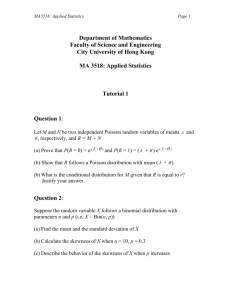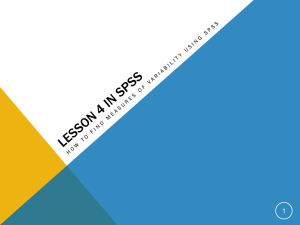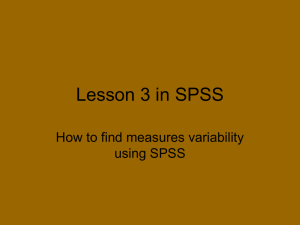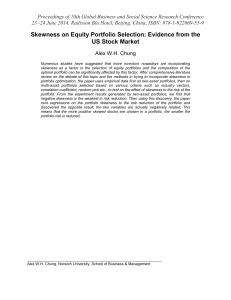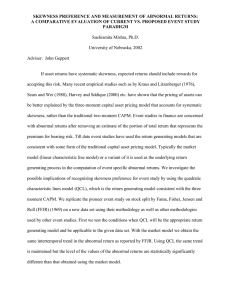LETTERS Image statistics and the perception of surface qualities Isamu Motoyoshi
advertisement
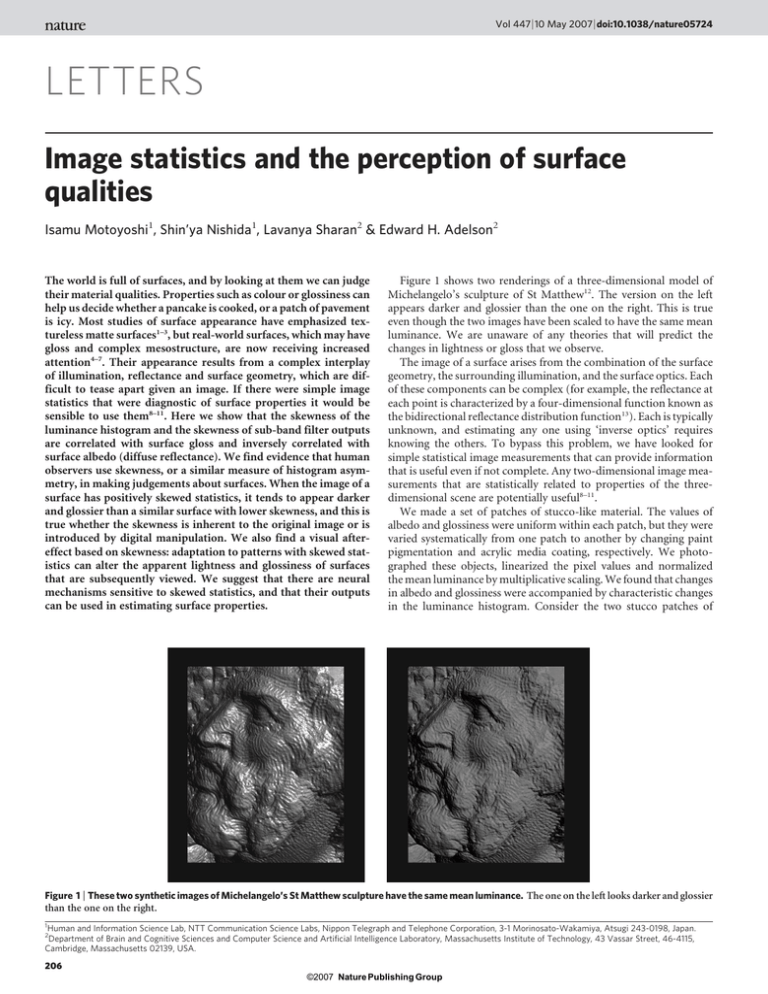
Vol 447 | 10 May 2007 | doi:10.1038/nature05724
LETTERS
Image statistics and the perception of surface
qualities
Isamu Motoyoshi1, Shin’ya Nishida1, Lavanya Sharan2 & Edward H. Adelson2
The world is full of surfaces, and by looking at them we can judge
their material qualities. Properties such as colour or glossiness can
help us decide whether a pancake is cooked, or a patch of pavement
is icy. Most studies of surface appearance have emphasized textureless matte surfaces1–3, but real-world surfaces, which may have
gloss and complex mesostructure, are now receiving increased
attention4–7. Their appearance results from a complex interplay
of illumination, reflectance and surface geometry, which are difficult to tease apart given an image. If there were simple image
statistics that were diagnostic of surface properties it would be
sensible to use them8–11. Here we show that the skewness of the
luminance histogram and the skewness of sub-band filter outputs
are correlated with surface gloss and inversely correlated with
surface albedo (diffuse reflectance). We find evidence that human
observers use skewness, or a similar measure of histogram asymmetry, in making judgements about surfaces. When the image of a
surface has positively skewed statistics, it tends to appear darker
and glossier than a similar surface with lower skewness, and this is
true whether the skewness is inherent to the original image or is
introduced by digital manipulation. We also find a visual aftereffect based on skewness: adaptation to patterns with skewed statistics can alter the apparent lightness and glossiness of surfaces
that are subsequently viewed. We suggest that there are neural
mechanisms sensitive to skewed statistics, and that their outputs
can be used in estimating surface properties.
Figure 1 shows two renderings of a three-dimensional model of
Michelangelo’s sculpture of St Matthew12. The version on the left
appears darker and glossier than the one on the right. This is true
even though the two images have been scaled to have the same mean
luminance. We are unaware of any theories that will predict the
changes in lightness or gloss that we observe.
The image of a surface arises from the combination of the surface
geometry, the surrounding illumination, and the surface optics. Each
of these components can be complex (for example, the reflectance at
each point is characterized by a four-dimensional function known as
the bidirectional reflectance distribution function13). Each is typically
unknown, and estimating any one using ‘inverse optics’ requires
knowing the others. To bypass this problem, we have looked for
simple statistical image measurements that can provide information
that is useful even if not complete. Any two-dimensional image measurements that are statistically related to properties of the threedimensional scene are potentially useful8–11.
We made a set of patches of stucco-like material. The values of
albedo and glossiness were uniform within each patch, but they were
varied systematically from one patch to another by changing paint
pigmentation and acrylic media coating, respectively. We photographed these objects, linearized the pixel values and normalized
the mean luminance by multiplicative scaling. We found that changes
in albedo and glossiness were accompanied by characteristic changes
in the luminance histogram. Consider the two stucco patches of
Figure 1 | These two synthetic images of Michelangelo’s St Matthew sculpture have the same mean luminance. The one on the left looks darker and glossier
than the one on the right.
1
Human and Information Science Lab, NTT Communication Science Labs, Nippon Telegraph and Telephone Corporation, 3-1 Morinosato-Wakamiya, Atsugi 243-0198, Japan.
Department of Brain and Cognitive Sciences and Computer Science and Artificial Intelligence Laboratory, Massachusetts Institute of Technology, 43 Vassar Street, 46-4115,
Cambridge, Massachusetts 02139, USA.
2
206
©2007 Nature Publishing Group
LETTERS
NATURE | Vol 447 | 10 May 2007
Number
of pixels
a
0
1 0
3
Skewness
2
0
1
4
Lightness rating
0
c
3
Glossiness rating
Lightness rating
3
2
1
–2
0
2
Skewness
0
1
Skewness
–2
1
10
100
Specular intensity
3
2
1
–2
0
2
Skewness
4
4
Glossiness rating
Lightness rating
3
Glossiness
rating
2
0
–4
4
4
3
2
1
0
–4
1
4
4
d
3
0
0.1
–2
1
10
100
Diffuse reflectance (%)
0
–4
0.5
Luminance
Skewness
Lightness rating
4
Glossiness rating
b
0.5
Luminance
Skewness
Fig. 2a. In comparison with a light matte surface (left), a dark glossy
surface (right) has a long positive tail. In general, as the albedo of
glossy surfaces is decreased, or as the glossiness is increased regardless
of the albedo, the histogram’s skewness tends to increase (Fig. 2b;
black circles). These changes make sense given the influence of
specular and diffuse reflectance on the appearance of specular highlights. Highlights are stronger and sharper on glossy surfaces, and
they have higher contrast when viewed on darker surfaces, because
they are seen against a body surface that has a lower luminance.
Having observed this physical relationship, we next looked for a
corresponding psychophysical relationship. We showed these stucco
images, one by one, to human observers, presenting them against a
dark background on a monitor at constant mean luminance, and asked
the observers to rate the lightness (perceived diffuse reflectance) or
glossiness of each surface. The judgments were well correlated with the
corresponding physical properties, as shown in Fig. 2b (red circles).
Both the lightness and glossiness ratings were also well correlated with
the skewness of the luminance histogram (Fig. 2c) to a degree comparable with, or even higher than, the correlations with corresponding
physical properties (r 5 20.87 for correlation with skewness of lightness ratings, and 0.89 for glossiness ratings, respectively).
We next chose a set of images of three materials (stucco, black
cotton fabric and crumpled white paper, all of which were surfaces
of uniform albedo and glossiness) and used a lookup table to force the
luminance histograms to have specific skewness values. As expected,
the lightness rating showed a strong negative dependency on skewness, whereas the glossiness rating showed a strong positive dependency. This was true for each image class (Fig. 2d). Further tests of a
wide variety of materials gave similar results, described in Supplementary Data A.
In addition to the effects of skewness, we found a minor effect of
the standard deviation of the luminance histogram on both lightness
and glossiness. The mean luminance had a significant effect on
lightness1–3, but not on glossiness. We found little, if any, effect of
kurtosis (Supplementary Data B).
The above results indicate that skewness or a similar measure of
histogram asymmetry is useful in estimating surface qualities, and
that humans may indeed use it. How might such statistics be computed at the neural level? The early stages of vision are dominated by
neurons that represent luminance variation in certain sub-bands of
spatial frequency. These cells do not have direct access to raw luminance, but there is a strong correlation between sub-band skewness
and luminance skewness for the uniform albedo surfaces we used
(r $ 0.86 for sub-bands at spatial frequencies ranging from 4 to 64
cycles per image, obtained with two-octave gaussian bandpass filters). We note that sub-band statistics also have certain advantages
over luminance statistics, because they reflect spatial image structure
whereas luminance statistics do not (see also Supplementary Data D).
Skewness is a measure of the asymmetry of a distribution; it indicates the balance between the positive and negative tails. Various
definitions have been used14, the most popular being based on the
third standardized moment. If X is a random variable with zero mean
and unit variance, then skewness is the expected value of X 3 . If X is
the output of an array of neurons that act as sub-band filters, then
a neural implementation needs normalization, cubing, and summation over a region; these are easy to implement in neural hardware.
A bandpass neuron’s output already has zero mean, and local gain
control15 will tend to normalize the response variance over a given
region. Cubing and summing over a region are straightforward.
In more concrete terms, we suggest the flow diagram of Fig. 3. As
input, we use an image constructed from the two St Matthew images.
The image is filtered with on-centre and off-centre receptive fields
and split into separate (all positive) streams. The on-centre and offcentre responses each pass through an accelerating nonlinearity.
These responses are summed over a region, and these summed responses are subtracted. The difference signal is an estimate of local
–2
0
2
Skewness
4
3
Stucco
Paper
Fabric
2
1
0
–4
–2
0
2
Skewness
4
Figure 2 | Perceived lightness and glossiness may be based on the skewness
of the luminance histograms. a, The stucco-like surface on the right looks
darker and glossier than one on the left even though the mean luminance of
both images is equal. We note that the luminance histogram is negatively
skewed for the left image (skewness 5 21.34), and positively skewed
(skewness 5 2.40) for the right image. b, In the left panel, as the diffuse
reflectance increases, the lightness ratings given by human observers increase
(red circles, y-axis scale on the left side) and the skewness of the image
histogram decreases (black circles, y-axis scale on the right side). The data were
obtained with medium-glossy surfaces. In the right panel, we see that as the
specular reflectance increases, both the rated glossiness (red circles) and the
histogram skewness (black circles) increase. The data were obtained with darkgrey surfaces. c, The rated lightness (left panel) and glossiness (right panel) of
the 63 surface images of varying diffuse and specular reflectance under
different illumination conditions. The human ratings correlate well with the
skewness of the image histogram. Error bars represent 6 1 s.e.m across six
observers. d, The effect of histogram manipulation on perceived lightness and
glossiness. For images of stucco, crumpled paper, and fabric, the luminance
histogram was matched to a positively or negatively skewed beta distribution.
The rated lightness (left panel) and glossiness (right panel) varied according to
the final skewness of the manipulated image (mean 5 8.2 cd m22, s.d./
mean 5 0.1, See Supplementary Data B for data obtained with other
parameters). Error bars represent 6 1 s.e.m. across seven observers.
207
©2007 Nature Publishing Group
LETTERS
NATURE | Vol 447 | 10 May 2007
Figure 3 | A proposed neural
mechanism for encoding the subband skewness by early visual
units. The image is analysed by
on-centre and off-centre filters
followed by an accelerating
nonlinearity (square, cube and so
on). The outputs are then separately
pooled over space. The difference
between the pooled outputs of the
on- and off-centre channels
provides an estimate of the
sub-band skewness.
On
Off
Linear
Non
filters linearity
Spatial
pooling
Comparison
skewness. See Supplementary Discussion for a more formal description of the model.
Could this computation be supported with known physiology?
The on-centre and off-centre cells of the brain’s lateral geniculate
nucleus (LGN) would work as the initial stage, as would evensymmetric (‘bar detector’) simple cells. Next we require a cortical
cell that pools and compares the outputs of a set of such cells after a
a
b
c
Luminance
Pre-adapt
Percentage darker
100
Adapt (spots)
100
50
0
–1.5 –1 –0.5 0 0.5 1 1.5
Skewness offset
Percentage glossier
d
Luminance
Adapt (stucco)
50
0
–1.5 –1 –0.5 0 0.5 1 1.5
Skewness offset
nonlinearity. The classic complex cell will not suffice, because it is
insensitive to contrast sign. Our putative skewness cells would be
selective for contrast sign, but not for position and not necessarily
for orientation. Such cells would be excited by bright (or dark) dots
or lines anywhere within their receptive fields, but not by ones of the
opposite sign. There are various reports of cells in areas V1 and V2 of
the brain that are selective for contrast sign16–20, and these could
participate in the processing chain we are proposing.
The notion of ‘skewness detectors’ suggested a psychophysical
experiment. Suppose we adapt to a pattern with positive skewness,
and thereby shift the balance of sensitivities in the positive and negative skewness mechanisms. Would that shift our judgements of lightness and glossiness of a surface subsequently viewed?
We had subjects adapt to the patterns shown in Fig. 4a, which
consisted of quasi-randomly placed blurred spots. Subjects fixated
at a position between the two images. The adaptor with bright spots
had positive skewness and the one with dark spots had negative
skewness. After adaptation, two images of the same stucco surface
that differed only in the sign of their skewness values were presented,
side by side, as shown in Fig. 4b, and we asked subjects to judge their
relative lightness and glossiness. Both judgments were shifted in the
expected direction, as shown in Fig. 4d. We also used stucco images
with positive or negative skewness as adapters, as in Fig. 4c, and
found a similar shift. Thus, the effect is similar whether the adapting
stimulus looks like a surface or merely a set of random spots.
We determined that the skewness adaptation did not affect the
apparent brightness of the uniform grey test field of various luminance values. This ruled out the possibility that the lightness aftereffect was due to a simple change in the luminance transducer
function of the visual system.
We tested the inter-ocular transfer of the after-effects and found
that the after-effect caused by the different-eye adaptor was 76% 6
6.1% (95% confidence interval) of that by the same-eye adaptor
(estimated from the averaged results of three observers). Such
incomplete transfer points to a partial involvement of monocular
Figure 4 | After-effects of perceived lightness and glossiness. Observers
adapted to the artificial textures shown in a. These textures consist of oncentre (left) and off-centre (right) difference-of-gaussian elements. After the
prolonged observation of images in a observers were shown a pair of test
images (b). Although the test surfaces shown in b are physically the same,
observers saw the right surface as darker and glossier than the left one.
Similar after-effects were obtained after adaptation to natural surfaces with
skewed histograms, as shown in c. (See Supplementary Movies.) d, The
probability that the subjects judged one test image (on the side that adapted
to positive skewness), relative to the other test surface (on the side that
adapted to negative skewness) as darker (lightness judgement, left panel) or
glossier (glossiness judgement, right panel). Error bars represent 61 s.e.m.
across six observers. There were three adaptation conditions: no adaptation
(black circles), adaptation to artificial textures (difference-of-gaussian
patterns, blue circles), and adaptation to natural surfaces (stucco images, red
circles). The horizontal axis indicates the difference in skewness of the
luminance histogram of the two test images. Both plots in d correspond to
the case of adaptation to positive skewness. The shift of the psychometric
function indicates the after-effect.
208
©2007 Nature Publishing Group
LETTERS
NATURE | Vol 447 | 10 May 2007
sensors that are only evident in peripheral processing stages such as
retina, LGN and V1. Thus, some of the adaptable processing stages
might occur quite early in the visual system.
While skewness is predictive of perceived surface qualities, it can of
course be computed on arbitrary images, whether or not they look
like surfaces. A picture of fireworks against the night sky will be
positively skewed, but one cannot meaningfully judge its albedo or
gloss; the same is true of the adapting stimulus of Fig. 4a. Our findings were made in the case where the image is perceived as a surface of
uniform albedo with some highlights. We do not know what aspects
of image structure determine ‘surfaceness’ or ‘highlights’. When our
images are phase-scrambled so as to retain sub-band power, but not
phase structure, they are typically seen as plausible but not convincing surfaces. The lightness effects are retained, but glossiness is
lost. When the images are pixel-scrambled they are seen as twodimensional noise patterns without a unitary albedo or gloss.
These manipulations and the effects of spatial structure are discussed
further in Supplementary Data C and D.
Malik and Perona21 proposed that even-symmetric filters underlie
human sensitivity to contrast sign in texture discrimination. Chubb
et al.22, working with unstructured random noise textures, found
evidence for a ‘blackshot’ mechanism sensitive to dark outliers.
Our stimuli (which are seen as surfaces rather than two-dimensional
random patterns) and our task (judging surface quality rather than
discriminating textured regions) are quite different, but the processing could involve similar computations.
The present study gives an interesting perspective on neural computation and natural image statistics. Variance and kurtosis, which
are even-order statistics, have been vigorously studied23–25. Skewness,
an odd-order statistic, has been largely ignored. Even-order statistics
are always the same for an image and its negative, so that they are
blind to any asymmetries in light and dark (such as those that occur
with highlights and shadows). Skewness is specifically sensitive to
these asymmetries. It is easily computed, and we find psychophysical
evidence that it is used in human vision.
where q 5 10 2 p, l is the luminance and p is the parameter that controls skewness. In the after-effect experiment, subjects viewed an adaptation image pair
(Fig. 4a or c) for 100 s at the beginning of a session. In each trial, after 4 s of topup adaptation, a pair of oppositely skewed stucco images with a given skewness
magnitude was presented for 0.5 s, and the subjects indicated which of the two
surfaces appeared darker (or glossier). Methods are described more in detail in
Supplementary Methods.
Received 21 December 2006; accepted 26 February 2007.
Published online 18 April 2007.
1.
2.
3.
4.
5.
6.
7.
8.
9.
10.
11.
12.
13.
14.
15.
16.
METHODS
Photographs of real surfaces (24 handmade stuccos, fabric, and crumpled paper)
were taken by a 16-bit linear camera (Bitran BS-42N). The standard deviation
(s.d.) and skewness of the luminance histogram were defined as:
sffiffiffiffiffiffiffiffiffiffiffiffiffiffiffiffiffiffiffiffiffiffiffiffiffiffiffiffiffiffiffiffi
P
ðI ðx,y Þ{mÞ2
s:d:~
N
ð1Þ
P
ðI ðx,y Þ{mÞ3
skewness~
N (s:d:)3
where I(x,y) is the luminance of a pixel, m the mean luminance, and N the
number of pixels (256 3 256). Surface images were presented on a CRT monitor
(Sony GDM-F500R, refresh rate 100 Hz, luminance range of 0.1–82 cd m22)
through a graphics card (Cambridge Research System, VSG2/5), with 8-bit
luminance resolution for the luminance range of each image. The mean luminance of all images was normalized to 16.3 cd m22, and the background luminance was kept below 0.1 cd m22. In the first experiment (Fig. 2a–c), various
stucco images were presented in random order, and subjects rated the lightness
or the glossiness using a five-level physical scale (0 to 4). Physical samples
(Optical Society of America patches or stucco patches) were shown to the subject
as reference. In the second experiment (Fig. 2d), the skewness of the luminance
histogram of surface images was varied by the procedure of histogram matching
to a beta distribution, given by:
1
l p{1 ð1{l Þq{1
f (l)~
B ðp,qÞ
ð1
Bðp,qÞ~ l p{1 ð1{l Þq{1 dl
0
ð2Þ
17.
18.
19.
20.
21.
22.
23.
24.
25.
Land, E. H. & McCann, J. J. Lightness and retinex theory. J. Opt. Soc. Am. 61, 1–11
(1971).
Gilchrist, A. et al. An anchoring theory of lightness perception. Psych. Rev. 106,
795–834 (1999).
Brainard, D. H. Color constancy in the nearly natural image. 2. Achromatic loci.
J. Opt. Soc. Am. A 15, 307–325 (1998).
Dana, K. J. et al. Reflectance and texture of real-world surfaces. ACM Trans. Graph.
18, 1–34 (1999).
Todd, J. T., Norman, J. F. & Mingolla, E. Lightness constancy in the presence of
specular highlights. Psych. Sci. 15, 33–39 (2004).
Pont, S. C. & Koenderink, J. J. Bidirectional texture contrast function. Int. J. Comp.
Vis. 62, 17–34 (2005).
Robilotto, R. & Zaidi, Q. Lightness identification of patterned three-dimensional,
real objects. J. Vis. 6, 18–36 (2006).
Nishida, S. & Shinya, M. Use of image-based information in judgments of surfacereflectance properties. J. Opt. Soc. Am. A 15, 2951–2965 (1998).
Fleming, R. W., Dror, R. O. & Adelson, E. H. Real-world illumination and the
perception of surface reflectance properties. J. Vis. 3, 347–368 (2003).
Dror, R. O., Willsky, A. S. & Adelson, E. H. Statistical characterization of real-world
illumination. J. Vis. 4, 821–837 (2004).
Fleming, R. W. & Bülthoff, H. H. Low-level image cues in the perception of
translucent materials. ACM Trans. Appl. Percept. 2, 346–382 (2005).
Levoy, M, et al. The Digital Michelangelo Project. Æhttp://graphics.stanford.edu/
projects/michæ (2004).
Nicodemus, F. Directional reflectance and emissivity of an opaque surface. Appl.
Opt. 4, 767–773 (1965).
MacGillivray, H. L. Skewness and asymmetry: measures and orderings. Ann. Stat.
14, 994–1011 (1986).
Heeger, D. J. Modeling simple-cell direction selectivity with normalized, halfsquared, linear operators. J. Neurophysiol. 70, 1885–1898 (1993).
Schiller, P. H., Finlay, B. L. & Volman, S. F. Quantitative studies of single-cell
properties in monkey striate cortex. I. Spatiotemporal organization of receptive
fields. J. Neurophysiol. 39, 1288–1319 (1976).
Baizer, J. S., Robinson, D. L. & Dow, B. M. Visual responses of area 18 neurons in
awake, behaving monkey. J. Neurophysiol. 40, 1024–1037 (1977).
Shipp, S. & Zeki, S. The functional organization of area V2, I: specialization across
stripes and layers. Vis. Neurosci. 19, 187–210 (2002).
Kagan, I., Gur, M. & Snodderly, D. M. Spatial organization of receptive fields of V1
neurons of alert monkeys: comparison with responses to gratings. J. Neurophysiol.
88, 2257–2274 (2002).
Mata, M. L. & Ringach, D. L. Spatial overlap of ON and OFF subregions and its
relation to response modulation ratio in macaque primary visual cortex.
J. Neurophysiol. 93, 919–928 (2005).
Malik, J. & Perona, P. Preattentive texture discrimination with early vision
mechanisms. J. Opt. Soc. Am. A 5, 923–932 (1990).
Chubb, C., Landy, M. S. & Econopouly, J. A visual mechanism tuned to black. Vision
Res. 44, 3223–3232 (2004).
Olshausen, B. A. & Field, D. J. Emergence of simple-cell receptive field properties
by learning a sparse code for natural images. Nature 381, 607–609 (1996).
Simoncelli, E. P. & Olshausen, B. A. Natural image statistics and neural
representation. Annu. Rev. Neurosci. 24, 1193–1216 (2001).
Kingdom, F. A. A., Hayes, A. & Field, D. J. Sensitivity to contrast histogram
differences in synthetic wavelet-textures. Vision Res. 41, 585–598 (2001).
Supplementary Information is linked to the online version of the paper at
www.nature.com/nature.
Acknowledgements We thank Y. Li for discussions. L.S. and E.H.A. were supported
by NTT and by a grant from the National Science Foundation to E.H.A.
Author Information Reprints and permissions information is available at
www.nature.com/reprints. The authors declare no competing financial interests.
Correspondence and requests for materials should be addressed to I.M.
(motoyosi@apollo3.brl.ntt.co.jp).
209
©2007 Nature Publishing Group
